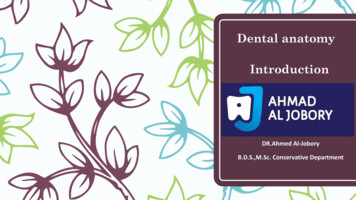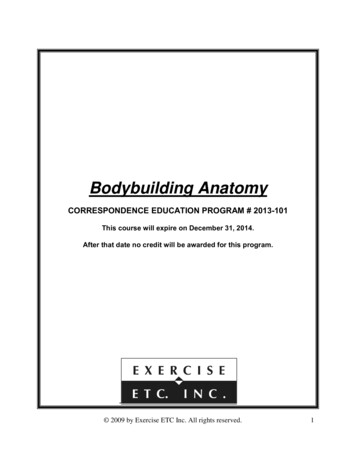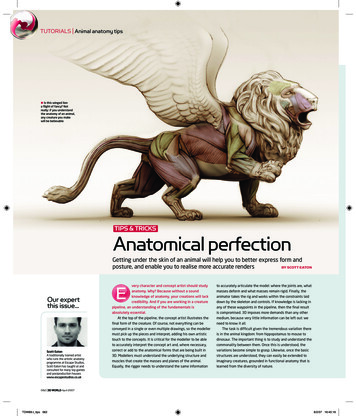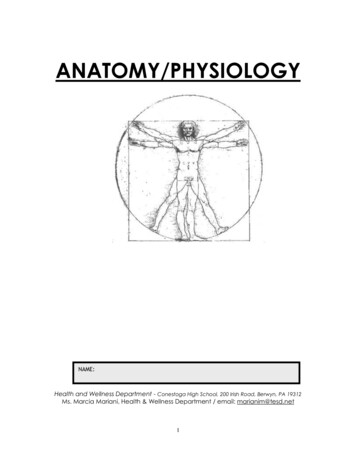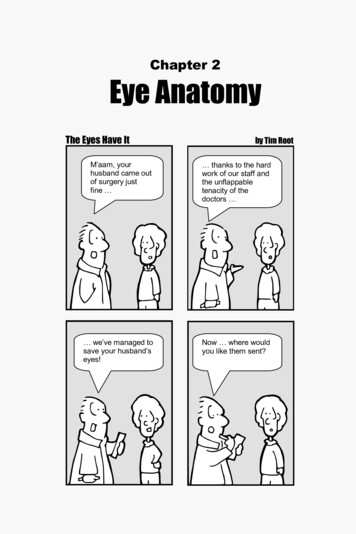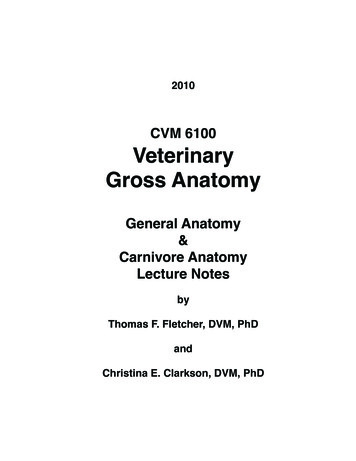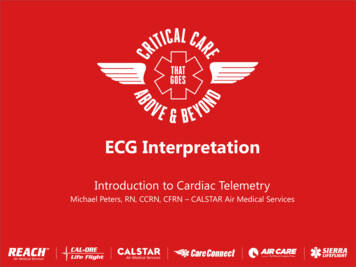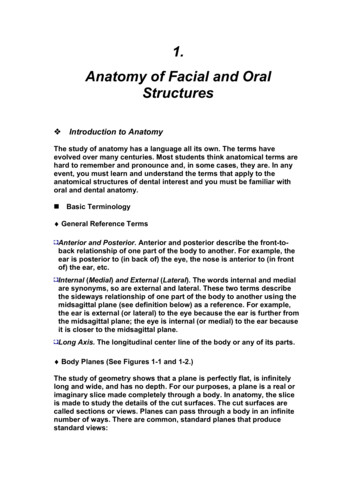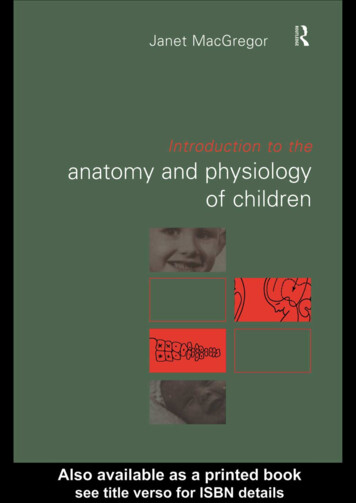
Transcription
Introduction tothe Anatomyand Physiologyof ChildrenThis is an excellent introduction to normal, healthy physical development forprofessionals who specialise in working with children. The author, an experiencednurse teacher, guides the reader through the key changes in body systems andfunctions from embryo to birth through childhood and adolescence.Chapter 1 sets the scene of physical needs in child development, such as theneed to be warm and safe. Chapters 2 to 9 cover the body systems: skeletal;nervous; cardiovascular; respiratory; renal; digestive; reproductive; and immune.The embryology and physiological function at birth is explored in these chaptersbefore the text addresses changes at puberty. In the final chapter screeningprocesses are presented, and the concept of the happy child being completelyhealthy is presented.Each chapter is illustrated with line drawings and tables, and ends with ascenario which encourages the student to apply the information provided toreal-life situations, and a question designed to extend, through further reading,the student’s knowledge and understanding.Concise and clearly written, this introductory text will be essential readingfor nurses following the child branch of the DipHE in Nursing, for studentmidwives, health visitors, school nurses and nursery nurses.Janet MacGregor is Senior Lecturer in Nursing Science and Paediatrics atChristchurch College, Canterbury.
Janet MacGregorLONDON AND NEW YORKROUTLEDGEIntroduction tothe Anatomy andPhysiology ofChildren
First published 2000by Routledge11 New Fetter Lane, London EC4P 4EESimultaneously published in the USA andCanadaby Routledge29 West 35th Street, New York, NY 10001Routledge is an imprint of the Taylor & FrancisGroupThis edition published in the Taylor & Francise-Library, 2001. 2000 Janet MacGregorAll rights reserved. No part of this book maybe reprinted or reproduced or utilised in anyform or by any electronic, mechanical, orother means, now known or hereafterinvented, including photocopying andrecording, or in any information storage orretrieval system, without permission in writingfrom the publishers.British Library Cataloguing in Publication DataA catalogue record for this book is availablefrom the British LibraryLibrary of Congress Cataloging-in-PublicationDataMacGregor, JanetIntroduction to the anatomy and physiologyof children/Janet MacGregor.p cm.Includes bibliographical references and index.1. Children–Physiology. 2. Human anatomy.3. Child development. I. Title. [DNLM: 1.Child Development. 2. Anatomy–Child.3. Anatomy–Infant. 4. Physiology–Child.5. Physiology–Infant. WS 103 M146i LCCIPISBN 0–415–21508–0 (hbk)ISBN 0–415–21509–9 (pbk)ISBN 0-203-18331-2 Master e-book ISBNISBN 0-203-18406-8 (Glassbook Format)
This book is dedicated to my students and thechildren we care for.I am particularly grateful to four ‘little people’,whom I have studied closely in compiling thisbook:MorganGeorgeAnnabelHamishMay these reflections on your individualdevelopment help those who are interested inother children’s physical development tounderstand all children’s needs and thus providethe optimum environment for them to achievetheir unique genetic potential.Thank you.
List of illustrationsPreface1 Child physical needsxiiixv1Child development theoriesThe nature–nurture debateGenetic inheritanceA healthy environmentThe need for protective careProtection from visible risksAccidental injuryNon-accidental injuryProtection from invisible (biological) riskImmunisationThe need for foodThe need for temperature controlThe need for activity and restPhysiology knowledge in practiceScenarioExtend your own knowledge2345666799912131414162 The skeletal system17EmbryologyThe changing skeletonGrowth in heightGenetic inheritanceHormones of growth1818202123ContentsContents
CONTENTSVIIIDiet calcium for bone growthExerciseNature–nurtureChanges in bone due to exerciseStrengthPhysical activity playBody shape changesPhysiology knowledge in practiceScenarioExtend your own knowledge262626272728293232323 The nervous system35Brain growth embryologyNerve growthThe eyeThe earBirth onwardsThe brainThe nervesReflexesPsychological maturationNeuromuscular controlGeneral functional areasBody locationSleepTemperature controlPhysiology knowledge in practiceScenarioExtend your own knowledge36374041424243444646474848515353544 The cardiovascular system55Heart embryologyFoetal heart circulationCirculation changes in the heart at birthChanges in the cardiovascular system in childhoodExercise and cardiovascular functionBlood pressure and exerciseChildren’s bloodCommon blood testsGuthrie TestRoutine diet supplementVitamin KPhysiology knowledge in practice565659606262646565666666
CONTENTSScenarioExtend your own knowledge66675 The respiratory system69EmbryologySurfactantThe lungs at birthThe first few weeksBaby breathingApnoeaRespiratory resuscitationAssessmentActionThe small child’s breathingChanges at pubertyRespiration during exerciseSleep and breathingDevelopment of the earPhysiology knowledge in practiceScenarioExtend your own knowledge70717272737475757778787982828585856 The renal system87EmbryologyThe kidney and urine production at birthFluid requirements in the first weekContinenceBed wetting – enuresisWater balanceUrineCollecting urineObserving urineTesting urineDehydrationOral rehydrationOver-hydrationReplacement of body electrolytes by dietPhysiology knowledge in practiceScenarioExtend your own X
CONTENTS7 The digestive system103EmbryologyThe mouthPhysical assessment of the mouthReflexes of the mouth and throatThe stomachThe gutWeaningFailure to thriveToo little inFailure to utilise nutrientsToo much outCalorie needs as basic metabolic rate(BMR) changesTeethLiver maturationPhysiological jaundiceBowelsBabies’ stoolsPhysiology knowledge in practiceScenarioExtend your own knowledge1041041061071071101111121121121128 The reproductive system121EmbryologyChanges at birthBody composition and sex differencesBody fat and sex differencesBrown fatChanges in the reproductive system at pubertySecondary sexual characteristics in male and femaleOvary cycleMenstrual cycleExercise and secondary amenorrheaPhysiology knowledge in practiceScenarioExtend your own knowledge1221241251251261271271281301321331331349 The immune systemProtection from micro-organismsAcquisition of immunityLymphocyte 7
CONTENTSB cellsEmbryology of the thymus gland andT lymphocyte developmentLymph vessel developmentLymphocytes in the foetus and new bornStressChronic stress hormonesImmunisationPoints of interest when vaccinating childrenThe futurePhysiology knowledge in practiceScenarioExtend your own knowledge13714014114114214414614814814914915010 Coordinating the systems151Thyroid gland effect in growthScreeningFoetal growthThe school-aged childThe five year oldThe seven to eight year oldThe eleven to twelve year oldThe fourteen year oldVisionHearingWeightHeightThe role of the thyroid in all tissue developmentThyroid hormonesThe importance of the hypothalamus in linkingthe physical with the psychological personThe happiness factorPhysiology knowledge in practiceScenarioExtend your own XI
ry and secondary ossification centresDevelopment of the four vertebral curvesBone structure in the infant and adolescent skullThe growth plateHow body proportions change with ageBrain growth, 30–100 daysAxon myelinationThe most active parts of the brain at birthGeneral functional areas in the cerebral cortexThe ‘sleep centres’ in the brainForamen ovale and ductus arteriosisFoetal circulationCirculation after birthLung buds at week four and bronchi at week fiveThe Eustachian tube’s positionThe Eustachian tube opening in the nasopharynxKidney bud positionBladder sphinctersThe reflex arc for bladder emptyingSucking from the breastSucking from the bottleThe oesophagus sphincterInternal and external anal sphinctersThe Müllerian and Wolffian systemsUterine lining, ova changes and circulating 05109117123132
I L L U S T R AT I O N S9.19.29.39.410.110.2Sequence of T and B lymphocytes’ action on antigenThymus developmentThe ‘acute’ stress responseThe ‘chronic’ stress responseMigration of thyroid glandHypothalamus development at foetal week 26.16.26.36.47.17.27.39.110.110.2Apgar score sheetNormal paediatric cardiac output:stroke volumeHeart rates in childhoodBlood pressure changes over childhoodNormal haematology in childhoodBody mass index, 50th percentile rangeResuscitationRespiratory rates in childrenA rough guide for electrolyte requirementsFluid requirements in the first week after birthDaily fluid requirements for childrenUrine output by ageStomach capacities by ageEstimated average requirements for dietary energyExpected weight gains for children in the UKRecommended immunisation schedule for the UKBody mass index expressed as percentileNormal serum levels of triiodothyronine, total T3-RIAin childhood10.3 The interrelationship of hypothalamic 8160164
PrefaceThis book is not a comprehensive guide to children’s physical development, butan introduction to some selected topics commonly discussed with studentsworking in child health contexts, and for parents who wish to provide theoptimum environment for their offspring to flourish.There is a wide range of ‘normal’ at any age, no more so than in the periodbefore adult attributes are attained. However, there are physical milestones thatall children reach in a definite sequence, and these milestones are universal.Most parents note the age their baby rolls and sits; most teachers knowwhich skills their pupils should be able to perform; most health professionalsknow the parameters of their small charges’ vital signs.The content of this book, which is for parents, teachers and health professionals, will first set the scene for physical development to take place. Twodevelopment theories have been chosen which present the nature–nurtureeffect on physical change. Some selected topics are then addressed, such ashealthy environments and health promotion issues, which should facilitate children’s optimal growth. The succeeding chapters then investigate the bodysystems in more detail, where it is hoped the reader will be stimulated to taketheir own interest further and research some of the topics more fully. The finalchapter takes the reader back from the physical to the psychological, and thuscompletes the circle, where a healthy body is intricately entwined with a happychild.
Child physical needs Child development theories The nature–nurture debate Genetic inheritance A healthy environment The need for protective care Immunisation Healthy diet Keeping warm ExerciseChapter 1Chapter 1
Tof children is part of their whole development and therefore must be seen in the context of the social,emotional and intellectual changes that occur through childhood.Child development theories reflect the philosophies of their variousauthors, but as the subject is so complex, these have often beenformulated from a particular stance. For this discussion, two theories have been selected to support the genetic and environmentaleffects on physical change. Inherited influences can be both subtleand obvious, as can the more long-term effects of environment. Theeffects of both interact over many years from conception to adultstatus; they are instrumental in changing the child as it physicallygrows and matures.HE PHYSICAL DEVELOPMENTChild development theoriesBee (1997) suggests that there are three fundamental child development concepts that need to be understood: the way in which children are the same and differentthe internal and external influences on these changeswhether changes are quantitative or qualitative in natureTo this end, there are two groups of theories on development that arehelpful in understanding the changes that occur in the ‘physical’ child,and reflect the internal and external nature of the influences forchange. These are the biological theories and the learning theories.Biological theories are based on common patterns of development and the unique individual behavioural tendencies that arepartially programmed by genetic inheritance. The development ofsitting, for example, occurs as the maturation of systems allows thisskill to occur. There is some acknowledgement that the child mustbe in an environment that facilitates this, and that the child has theinclination to do so.The biological changes are both quantitative and qualitative innature; children can be ‘aged’ by the degree of ossification of theirskeletal system. However, their genetic inheritance, the degree ofactivity they have experienced and their usual diet will ensure children will all be slightly different. It is with this biological philosophythat the succeeding chapters will explore the physical changes thatoccur in childhood.2
CHILD PHYSICAL NEEDSThe second group of theories comprises the learning theories,which propose that only reflexes are inherited and that all subsequentbehaviour changes are learnt. For such theorists, the environmentalinfluence is most important, together with the process within that oflearning. The learnt behaviour that takes place can only be inferredfrom observing the changed behaviour. It is a learnt behaviour thatmust be relatively permanent and which results from past experience (Gross 1996). These learnt behaviours then becomecumulative in nature, and require memory to allow them to develop.They are qualitative in nature – the child can be seen to perform askill more successfully. Children learning to skip show this qualitative development: at first they cannot coordinate the rope with theirfeet, but with practice they soon develop sophisticated movementsas they work with the rope. A learnt behaviour can also arise from aconditional response, such as the child being praised for eatinglunch. This is called the law of effect, where there is a pleasurableexperience in performing a task that perhaps is not initiated by thechild. Much behaviour therapy uses this technique when the tempertantrum is ignored but the acceptable response rewarded. An alternative learning theory is that of watching rather than doing; thelearnt behaviour developing through an interpersonal situation.Here the child will watch a role model and see the consequence ofthis model’s actions. If children value the result of the action theywill use the behaviour themselves. Young children watch older children using the toilet and being praised for this action, so they willmimic their behaviour. They also see older children scream andshout to get their own way, and copy this!The nature–nurture debateThe nature–nurture debate reflects the biological and learning theories discussed above. Inherited and environmental factors are bothshown to play an important role in ensuring that the child willdevelop into a unique individual. Adult height is achieved throughthe interaction of the inherited potential from both parents, and thechild growing in an optimum environment, such as one where theyreceive adequate nutrition and are free from disease. There havebeen such environmental changes in most Western populations overthe past fifty years, and children at the end of the 1990s are growing taller and maturing earlier. The complex interaction between3
I N T R O D U C T I O N T O T H E A N AT O M Y A N D P H Y S I O L O G Y O F C H I L D R E Ninheritance and environment may still be seen in changes that occurin recently migrating populations. Those groups who, for example,change their diet and lifestyle, and perhaps marry into the indigenous race when settling into a new country, may see their children’sphysical growth and maturation change over many future generations (McQuaid et al. 1996).Genetic inheritanceInherited characteristics are transmitted from one generation to thenext in a random way, and they strongly affect the end result ofgrowth and the progress towards it. There is a high correlation witha child and parent regarding height, weight, shape and form of features,body build and skin colour. Many dimensions of personality, such astemperament, also seem to be inherited (Wong 1999). Inheritedpotential is decided at conception as the genes from both father andmother combine to form the new individual.Early research established that some genes were dominant toothers and held the more likely characteristics to be expressed, suchas hair colour and eye colour. Recessive genes, those that were‘hidden’ by the dominant genes, provide the ‘throwback’ phenomenon produced when both parents carry the recessive characteristic.Thus two ‘coloured’ individuals could produce a black and a whitechild as siblings. It is now commonly believed that it is not genesthat are individually expressed, but the interaction of these inheritedcharacteristics that generally produces many of an individual’sfeatures. The unusual colouring of ginger hair and green eyes, orthe unexpected stature of a very small son or daughter, may beexamples of this phenomenon. Genetically inherited characteristicscan also be seen in the distinct racial groups. Afro-Caribbean children develop their muscular skeletal systems in advance of white orChinese children, regardless of their diet or environment. Blackbabies hold their heads up well, and may sit and stand earlier thanthose of other racial groups.Berger (1998) reports that the Human Genome Project is all setto present the fully sequenced human genome in 2003. Apart fromthe basic sequencing of the genome, and the plan to study humangenetic variation and human susceptibility to disease, the Project isalso sequencing the genomes of other important organisms, includingthe mouse, yeast, fruit fly, Japanese puffer fish and roundworm. The4
CHILD PHYSICAL NEEDScollaboration involves Britain, the USA, France, Japan and Germany.New treatments using genetic engineering are already today helpinginfertile couples to conceive their child using artificially stimulatedoogenesis, donated eggs and sperms, and ‘wombs for rent’. Thecloning of animals has been successful, and the manufacture ofmedications which replicate the genetic patterning of the naturalproduct is widely practised. Genetic scientists can predict sex andsome physical abnormalities: the construction of a human child isnot a dream.A healthy environmentPhysical health in children’s early years is of paramount importance;they must be given the best possible chance of a healthy future. Asthey grow and change, so their health needs change for them toachieve their genetic potential. Many factors influence their physicalhealth before and after birth. Children’s views about their healthalso change as they experience the world, adapt and refine theirpurpose in life. Moules and Ramsey (1998) offer a definition ofhealth taken from developmental psychologists, one which emphasises ‘actualisation’, the realisation of human potential throughpurposeful action. They suggest that this developmental approachto health promotion for children is most appropriate, as it parallelsthe development of cognitive processes. Thus children of six yearswill see health in a ‘concrete’ way, as enabling them to do what theywant to do: play outside and go to school. The teenager, however,will find the task of defining health more difficult and probe thequestioner for context, seeing health as something more ‘abstract’that involves both body and mind.There are projects in cities aimed at making the environmentmore friendly to children, such as the Healthy Cities Project initiated by the World Health Organisation (WHO). This initiative hasnow been extended to the worldwide Healthy Cities Movement.One of its targets relates to health-promoting physical and socialenvironments, concentrating professional help into empoweringpopulations to develop skills that allow them to make healthychoices for living (Twinn et al. 1998). All children need safe areas forphysical play, away from pollution, noise and traffic, and they needto be encouraged to be physically active in activities they enjoy (seeChapters 2–4 on the skeletal, muscular and cardiovascular systems).5
I N T R O D U C T I O N T O T H E A N AT O M Y A N D P H Y S I O L O G Y O F C H I L D R E NThe following topics for health promotion are offered as importantto optimal physical development: the need for protective carethe need for foodthe need for temperature controlthe need for activity and restThe need for protective careChildren depend not only on their immediate carers for protection,but on the policies of the state to create a safe environment in whichthey can thrive. Hall (1996) stressed the importance of promotingchild health in the community, and one of his key recommendationswas for accident prevention measures. All body systems requirefreedom from the stresses of pain, anxiety and medical interventions, which are often part of the accident and illness experience, todevelop to their full potential. It is when children experience eithervisible or invisible (biological) harm that the development of theirphysical self is seen to suffer (see the section on stress in Chapter 9’sdiscussion of the immune system).Protection from visible risks – accidental and non-accidentalinjuryAccidental injuryAccidents are the single most reported cause of death in childrenbetween the ages of one and fifteen years; children are seen asadventurous, unpredictable and fun-seeking. However, those minoraccidents that happen in the home are rarely reported and perhapsare part of growing up. Children can be clumsy, impetuous andcurious, and their carers can be ignorant of their needs and lax insupervision. Families may live in poverty and the children be disadvantaged (Fatchcett 1995). Woodroffe et al. (1993) however, showthat death rates due to all accidents in the UK decreased between1969 and 1990. They suggest that this may be, in part, due to saferhome and local environments, advances in medical science and easyaccess to health care. However, constant minor injuries and their6
CHILD PHYSICAL NEEDSfrequent association with infections that do not kill may result in children expending their energy for tissue repair rather than for growth.The infant is at risk of falling due to the innate reflexes propellingthe child forward, for example, from the baby chair if not strappedin. Babies soon start to roll, and may roll from a changing mat tothe floor. At six months, small objects may be ingested or inhaled asthe baby grasps and investigates with the mouth. When crawling isachieved, the child will not know that interesting objects on thefloor are dangerous to eat.Young school-aged children are only beginning to understandcausal relationships and to think about the effects of their actions.They have improving muscle coordination and want to practise andperfect their physical skills. Cycling is a favourite activity for thisage group, but in the excitement of the chase they may forget towatch for cars that share the public domain. They are increasinglyexposed to more and various environments, and are easily distractedfrom a safe course by things that are seen as more interesting.Teenagers have often progressed to activities involving motorbikes and alcohol, which may frequently lead to involvement infights. Children of this age group have a need to establish themselves as independent and responsible for their own actions, and thiscommand over their own lives may lead them to feel indestructible.They may not consider the consequences of their actions if peergroup pressure is strong. They participate in more sporting activities,and are thus more exposed to physical injury (Wong 1999).Non-accidental injuryChild abuse is often the result of family stress, a need for parentingskills, and/or children frightened to ask for help. Few single influences on development, however, including severe abuse, haveinevitable future consequences for the child. It is the sum and direction of many positive and negative influences that will have abearing on the eventual outcome of their adjustment in adult life.Physical abuse is the most common single category for ‘at risk’registration; the trend is a decline for children under five years andis rising in those aged five to sixteen years. Other categories aresexual, emotional and neglect (Browne 1998; DOH 1991). One ofthe common indicators of any abuse is that the child will physically7
I N T R O D U C T I O N T O T H E A N AT O M Y A N D P H Y S I O L O G Y O F C H I L D R E Nfail to thrive (see Chapter 10). Sleep disturbance, eating disordersand ‘frozen awareness’ are behavioural indicators of children findingdifficulty in coping with their lives (Fatchett 1995).For a child to develop, he or she needs a secure attachment fromwhich to explore the world and to return to when anxious ordistressed (Adcock 1998). Fahlberg (1991) gives reasons for theimportance of attachment which has an effect as the child ‘unfolds’over time in the physical, social and emotional spheres of its life.The child needs a secure attachment to: attain his or her full intellectual potentialsort out what he or she perceivesthink logicallydevelop a consciencebecome self-reliantcope with stress and frustrationhandle fear and worrydevelop future relationshipshandle jealousyJones (1991) describes a series of key tasks of social and emotionaldevelopment which interrelate and influence each other: the baby’s achievement of a balanced physiological state in the firstfew weeks of lifethe development of a secure attachment with a carer in the firstyear of lifethe development of an independent sense of self in the first threeyears of lifethe establishment of peer relationships in the first seven years oflifethe integration of attachment, independence and peer relationshipsin the first twelve years of lifeThere appears to be a lack of agreement on the basic nature ofchildhood among professionals who aim to protect children fromharm. The Children Act (1989), in certain circumstances, allows forthe child’s wishes to be taken into consideration in any actioninvolving them, but the family in which they live may be permittedto have parental responsibility for decision-making, as children are8
CHILD PHYSICAL NEEDSconsidered to be physically weak, immature and powerless (Harris1998). This has resulted in professionals needing to control thefamily in order to protect the child. Child protection is nowperceived as distinct from child care, and the product of a relationship between the state, the family and the child to support thechild’s rights of citizenship.Protection from invisible (biological) riskImmunisationImmunisation programmes are available for all children in the UK.There are nine infections for which protection is routinely offeredat present. Today, these diseases are rarely seen; thus parents havebecome more concerned with the side-effects of the vaccines onhealthy children than with the effects of the infections themselves.The debate surrounding the measles, mumps, rubella (MMR) injections suggests, perhaps, that a more enlightened partnership withparents is required by the government of the day. With 25 per centof children in 1998 (Rejtman 1998) not vaccinated against theseinfections, it is feared that a major epidemic will occur in three tofour years’ time, with a whole series of children unnecessarily dyingor being damaged in one way or another. Rejtman also suggests thateffort in three areas should be made to prevent the crisis fromoccurring and to address the present anxiety of parents. First, largerand longer-term research must be carried out and the resultspublished to determine if the vaccine or its administration needs tobe altered. Second, information which explains the effects of thevaccine, both positive and potentially negative, should be freelyavailable and presented in a clear and concise manner. Third, thegovernment should consider offering the options of separatevaccines so that all children have some protection, rather than, as inthe present position, none at all.The need for foodDietary habits have shown some healthy trends in the past thirtyyears. Vegetarianism is on the increase, with 13.3 per cent of sixteento twenty-four year olds consuming this type of diet (Carter and9
I N T R O D U C T I O N T O T H E A N AT O M Y A N D P H Y S I O L O G Y O F C H I L D R E NDearmum 1995). There is less red meat, butter, cake and biscuitsconsumed, and more poultry, fresh fruit and brown bread eaten. Ahealthy diet should be based on a wide variety of foods, withemphasis on those foods of high nutrient density rather than thoseproviding energy only. This balanced diet can be achieved byselecting items from four food groups each day. Three can be takenfrom lean meat, fish, poultry, game, eggs, pulses and nuts; threefrom milk, cheese and yoghurt; four from bread, rice, pasta, breakfast cereal and potatoes; four from vegetables and fruit (NationalDairy Council 1995). Chan (1995) describes the Chinese custom ofbalancing the diet with reference to hot (Yang) and cold (Yin) foods,in order to ensure continuing health and to restore health after illness.Malnutrition and the subsequent detrimental effect on physicaldevelopment can result from lack of food, the wrong food and toomuch food. The effect of diet starts in the womb; the foetus relieson the mother to provide all the necessary nutrients for growth.The baby will grow at the expense of the mother if food is deficient,and Vines (1997) reports that these children,
the Anatomy and Physiology of Children. Janet MacGregor LONDON AND NEW YORK Introduction to the Anatomy and Physiology of Children ROUTLEDGE. First published 2000 by Routledge 11 New Fetter Lane, London EC4P 4EE Simultaneously published in the USA and Ca


